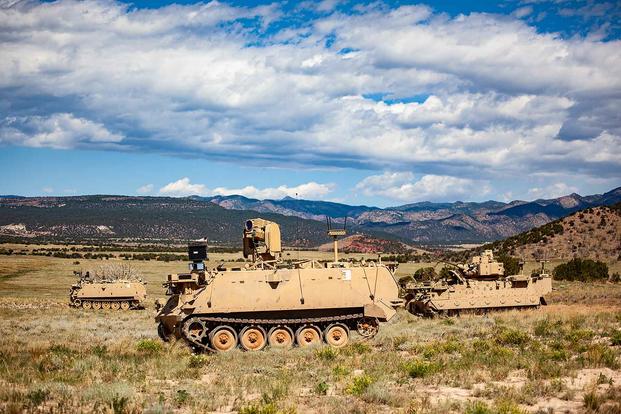Soldiers at Fort Carson, Colorado, want improvements added to the Army's Robotic Combat Vehicle prototypes to make them easier to control on the future battlefield.
Soldiers from Comanche Troop of the 4th Infantry Division's 4th Squadron, 10th Cavalry Regiment, recently completed the first Robotic Combat Vehicle Soldier Operational Experiment using two-soldier crews in specially modified Bradley fighting vehicles to control robotic surrogate vehicles fashioned from M113 armored personnel carriers.
Read Next: Army Sees Spike in COVID-19 Cases as Training Reaches Full Strength
Operating in the rugged terrain of Fort Carson, the soldiers performed cavalry-style missions while testing different technologies to control the robotic vehicles, sending them out hundreds of meters ahead to scout for enemy positions.
Overall, the soldiers said the RCV surrogate vehicles were easy to learn how to control, but they found problem areas that need fixing as the prototypes continue to develop, according to a recent Army news release.
Soldiers want better visibility, ranging from optics for sighting threats to camera positioning for detecting terrain.
"For me, specifically, I think that the ability to see downward once we approach certain inclines and declines would probably be an astute upgrade that would push us forward in the right direction," Sgt. Matthew Morris said in the release.
Sgt. Scott Conklin said shifting from a standard three-soldier crew to two soldiers was manageable, but the "frenetic pace" of using the 360-degree cameras presented a challenge.
The Army announced in January that it had selected QinetiQ North America to build four prototypes of the Robotic Combat Vehicle-Light, and Textron to build four prototypes of the RCV-Medium. Both companies were present at the experiment, but their prototypes are still being finalized and did not participate.
Soldiers used a controller based on an Xbox gaming system to control the surrogate vehicles.
"If you can play Mario Kart, you can drive a RCV," said Michael Rose, lead of the manned-unmanned teaming soldier operational experiment. "There's no handbook on this, so we're not only assessing the maturity of these technologies, but we're also writing the playbook on how we are going to fight with robots in the future. These soldiers are the first step in that process."
Another challenge to overcome is perfecting technology that will allow the control vehicle and the robot vehicle to communicate adequately beyond 1,000 meters in dense, forested terrain.
Several defense firms participating in the experiment have created radio waveforms capable of extending the range for better communications, Army modernization officials say.
"This is an experiment, and we chose that word very specifically: We have a hypothesis that manned-unmanned teaming will enable soldiers and leaders to more effectively fight on the battlefield," Brig. Gen. Richard Coffman, director of the Next Generation Combat Vehicle Cross-Functional Team, said in the release.
The next round of unmanned vehicle testing -- this time at the company level -- is scheduled to take place at Fort Hood, Texas, in 2022. The service also plans to conduct a third experiment in the future that will focus on more complex, company-size operations.
The Army is scheduled to make a decision in fiscal 2023 on when manned-unmanned teaming with RCVs will become a program of record, Coffman said.
-- Matthew Cox can be reached at matthew.cox@military.com.
Related: The Army Just Wrapped Up Its First Robot Vehicle Experiment. Here's What It Learned













